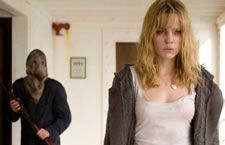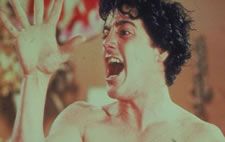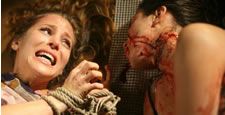
Triangle is a genre-savvy brainteaser
Last year's Film4 FrightFest featured quality horror aplenty, and at least five real standout films (TimeCrimes, Let The Right One In, The Chaser, The Midnight Meat Train, Martyrs) – and, yet, overall the festival was disappointing. This year's event again showcased plenty of quality, but arguably fewer films destined to be classics of the genre – and yet the festival was a real joy from start to finish. What was the difference? Well, everyone loves a birthday, and this was FrightFest's tenth, celebrated in style in new digs at Leicester Square's mighty Empire, where the screen is unfathomably large, the sound system shockingly loud and the seats impossibly comfortable – but that was not it.
The truth is more straightforward. As anyone compiling an album can attest, choosing the right tracks is important, but it is even more crucial to get the mix right. The opening night of 2008 featured the merely solid Eden Lake, followed by the truly execrable I Know How Many Runs You Scored Last Summer (which, along with Bubba's Chili Parlor, should never have been selected in the first place), and ended with the sub-par torture-slasher Scar. There was simply nothing there to grab the viewer by the eyeballs (apart from Scar's 3D format), and a bad mood was allowed to establish itself way too early, casting its dark shadow over the rest of the weekend.
This year's FrightFest, by contrast, opened with excellent genre-savvy brainteaser Triangle (unquestionably Chris Smith's finest film after his false starts with Creep and Severance), followed by Dave Parker's slasher The Hills Run Red (derivative, yet postmodern enough to get away with it - not to mention inventively gory), and ended with Kyle Rankin's joyfully schlubbish creature feature Infestation. Now that is the way to win over the good will of loyal weekend passholders from the outset.
There were only two occasions this year when the organisers got the mix wrong. The first involved the Festival's centrepiece, the world premiere of a digitally remastered version of John Landis' pioneering 1981 horror comedy An American Werewolf In London. This was attended by the director himself and a host of the original crew, but unfortunately spoilt in its impact by the decision to screen Paul Davis' feature-length (and overlong) making-of documentary Beware The Moon before rather than after the film it was dissecting.

Even Landis was evidently annoyed to see all his magic tricks being explained before they were performed, commenting: "Well, shit, now you know everything, there's no surprise." Still, at least American Werewolf inspired a series of hilarious nightly parodies by horror directors Adam (Hatchet) Green and Joe (Wrong Turn 2) Lynch (known collectively as the Douche Brothers), in which they affectionately sent up FrightFest, the horror genre, and themselves. As last year, their shorts (dubbed The Road To FrightFest) were to become a real highlight of the festival.
The only other false step was the decision to have an unscheduled screening (branded a 'surprise', but nonetheless leaked to the press) in Landis' presence of his full Michael Jackson 'Thiller' video as well as a rare feature-length Making-Of documentary from 1983. This was all very well for devotees of the late moonwalker, but for the rest of us it meant an unwelcome delay of an hour and a half before Sunday's midnight movie could finally get up and running.
Fortunately, the wait was well worth it, as Pierre Laffargue's Black turned out to be an exquisitely styled oddity in which the titular Parisian bankrobber (MC Jean Gab'1) heads back to his African roots (something Michael Jackson never did) after a heist gone wrong, only to see his criminal endeavours in Dakar transform into a mythic clash of the totems. Beautifully shot and groovily soundtracked, it is a strange hybrid of a film whose genre proves to be as mercurial as the form of its principal characters, with Franco-African history and identity being exposed in all their colourful contradictions.
There were several firsts at this year's FrightFest. Cult horror actor David Hess (Krug in the original 1972 The Last House On The Left) followed up his starring appearance in Lee Demabre's Smash Cut with a solo sub-Springsteen acoustic set on stage in Empire One; and the packed screening of Philip Ridley's Heartless was preceded by a live performance of songs from the film's soundtrack by leading man Jim Sturgess and his band. In keeping with the family atmosphere that has been carefully fostered by the festival over the last decade, this year also saw the birth of FrightFest's first set of twins (Zoe and Max), after a gravid regular reportedly broke her waters during a late-night screening of Vampire Girl Vs. Frankenstein Girl.

No doubt nature played a larger part than Yoshihiro Nishimura and Naoyuki Tomomatsu's high school shocker in inducing the birth. The film is the lastest in a long line of postmodern Japanese splatterpunk flicks (along with The Machine Girl, Meatball Machine and last year's jaw-dropping Tokyo Gore Police) that deliver an unmistakable blend of naïve cuteness and graphically high bodycounts. See one of these films, and you simply will not believe your eyes and ears – see more than one, however, and the jaded weariness begins to set in, for beyond its surface flash and flesh, this niche genre has absolutely zero depth. Still, there were some striking scenes of gleefully over-the-top, CG-enhanced gore – while the moments of out-and-out racism were somewhat less welcome and profoundly unfunny.
In fact, there were several films screened over the weekend (including the already mentioned Infestation and An American Werewolf In London) that were at the 'rollercoaster' end of the horror market, where visceral thrills (and even laughs) come thick and fast, but at the expense of any sort of broader subtext. All, however, did their job efficiently enough.
The Mo Brothers' Macabre, for example, may be a mash-up of elements familiar from The Rocky Horror Picture Show (1975), The Texas Chain Saw Massacre (1974), Inside (2007) and Dumplings (2005), but it builds expertly to a gore-gasmic climax of icky excess that will have any genre fan salivating. Gabe Ibanez's Hierro, on the other hand, has little to add to other recent supernatural chillers from Spain (especially The Orphanage), but is so extraordinarily well-crafted, so pleasing in purely aesthetic terms, that few will complain.
Similarly Ti West's The House Of The Devil, much like his earlier The Roost (2005), overcomes its utter unoriginality through the director's perfect mastery of set, mood and performance – and it captures the look and texture of an Eighties straight-to-video occult thriller with a spot-on accuracy that is of itself almost as uncanny as the goings-on within its hackneyed narrative.
Indeed, this year everyone seemed to be loving the Eighties. Tommy Wirkola's Dead Snow may conjure Nazi zombies from the Norwegian cold, but it also celebrates the sort of ghoulish toolshed comedy made famous by Sam Raimi's The Evil Dead (1981). Adam Gierasch's inevitably disappointing Night Of The Demons was an actual remake of the 1988 'classic' – and might have gone down better had anyone in the audience actually belonged to its teen demographic. Michael Dougherty's Trick 'R Treat revived the EC anthology format popularised by Creepshow (1982) and Twilight Zone: The Movie (1983), while presenting its multiple narratives as a Short Cuts-style tapestry rather than in chronological, episodic sequence. The resulting heady mix of hard candy and just deserts proved one of the most entertaining films of the weekend.

Another was Dario Argento's Giallo, if perhaps not for the right reasons. It is ineptly plotted, the dialogue is preposterous, the performances are absurdly broad, even the camerawork is laughably bad (including some particularly egregious uses of zoom), and it ends on a note so spectacularly arbitrary you will wonder if the editor just up and died in the middle of post-production – but, seen in a crowd, Giallo is also knee-slappingly hilarious, like some madcap Airplane-style spoof of everything Argento has ever done before. The giallo king has long rooted his films in disorienting suspense – here, however, the principal tension seems to rest in trying to discern just how in on the joke Argento actually is. Adrien Brody certainly gets it, dead-panning his way through two key rôles (one under the anagrammatic pseudonym Byron Deidra) like the thriller genre's answer to Leslie Nielsen.
The 'rollercoaster' film that left the biggest impression, however, was undoubtedly Tom Six's The Human Centipede (First Sequence), which might have been a bog-standard grafting of mad scientist motifs onto survival tropes, had it not been for the sheer lunacy (and, heh heh, medical accuracy) of said scientist's dastardly plans.
Dr Josef Heiter (Dieter Laser) is an expert in the separation of Siamese twins who has recently turned his twisted mind to the creation of conjoined triplets. The film coldly documents his abduction of three human subjects for the operation, and their harrowing attempt to escape his clutches while all surgically linked, mouth-to-anus. It is a sickly surreal psycho-chiller in which an arrogant god is pitted against the most abject of insects, and represents some sort of benchmark for films designed to push all the buttons of horror fans to the exclusion of practically everybody else. That said, even Jon Harris' The Descent: Part 2, for all its formulaic thrills, by-the-book jumpshocks and redemptive arcs, was much more fun than expected.
Then there were the films that spoke outside of their generic limits, or dared to do something different. Federico Zampaglione's Shadow, for instance, finds ingenious ways of tethering its backwoods slash-n-dash and torture-porn offcuts to much wider geopolitical concerns, while boasting, in cadaverous actor Nuot Arquint, the creepiest-looking on-screen antagonist since Max Schreck appeared as Count Orlok in the original Nosferatu (1922). Contemporary issues of societal breakdown are addressed, in somewhat different ways, through the zombified filters of Yannick Dahan and Benjamin Rocher's big-budget The Horde, and of Marc Price's no-budget (but intelligent and moving) Colin.
By gradually allowing its anemic hero to be overtaken and outclassed by an emerging heroine, Niels Arden Oplev's Millennium: The Girl With The Dragon Tattoo (based on the best-selling novel by the late Stieg Larsson) fleshes out its potboiler tropes with a subversive disregard for the gender norms of the serial killer genres – all of which fits well with its thematic focus on the cyclical legacies of paternal abuse.
Similarly, Rupert Glasson's Coffin Rock may follow the 'crazed interloper' template of Adrian Lyne's Fatal Attraction (1987) - complete with a bludgeoned joey as Australian equivalent of the boiled bunny – but such genrebound elements never fully disguise either the unusually subtle quality of the writing and performances, not to mention a more general preoccupation with anxieties about fertility, paternity and family.
In their different ways, Dave Parker's meta-slasher The Hills Run Red, Lee Demabre's cheap-and-disposable industry satire Smash Cut, and Anthony DiBlasi's bleak psychological horror Dread all raise uncomfortably reflexive questions (especially for a horror audience) about the vicarious thrills to be had from watching other people's fear and suffering – although only the last of these, based on a short story by Clive Barker, has any real, enduring worth.
Meanwhile The Horseman directed its revenge-and-torture-driven plotting at the thorny ethics of the porn industry and revenge itself – and Philip Ridley's ambitious-if-flawed comeback Heartless does so many things at once that one would be hard-pressed to pin down its genre (kitchen sink drama, urban horror, Lynchian thriller, Faustian morality play, folkloric allegory, black comedy?) from one moment to the next.
So what was the best of the Fest? Well, Trick 'R Treat, The Human Centipede and The House Of The Devil all come high on the list, as does Black (even if it hardly qualifies as horror at all), and in particular the festival opener Triangle, whose labyrinthine perfection made it a film that was replaying in the head for the whole long weekend.
For while Chris Smith has littered his loopy story with a trail of references to other, momentarily similar films (Dead Calm, Adrift, Ghost Ship, The Shining, TimeCrimes, Carnival Of Souls, even Pirates Of The Carribean: At World’s End) - references that afford viewers the pleasure of recognition - these hermeneutic breadcrumbs are never quite enough to resolve fully all the Möbian madness of Triangle itself, or to square the circle of its infuriating narrative. Triangle leaves you feeling no less lost, confused and full of despair than its heroine Jess (Melissa George) as she struggles, seemingly in vain, against the darker aspects of her own nature. If Alain Resnais' masterpiece Last Year In Marienbad (1961) had been set on a boat, in colour, with a lot of blood, it might have been something like this. That is high praise indeed.

Still, my favourite horror film of FrightFest 2009, and indeed of the year in general so far, was strangely not shown in the main auditorium, but relegated to the all-new Discovery Programme in the more intimate confines of Empire Four. Ostensibly about a shock jock (played half-cool, half-bewildered by the incredible Stephen McHattie) and his two-woman production team who find themselves besieged in their own basement studio by an external zombie-like threat, Bruce McDonald's Pontypool throws up so many Freudian slips, mixed metaphors and free-associative leaps that in the end the main characters' (and our own) grip on reality comes unstuck, and the unfolding apocalypse takes on a positively Saussurean aspect.
For in this wonderfully cerebral chiller set in small-town Ontario, nothing is more horrifying, entrapping, or ultimately liberating than the arbitrariness of the sign – and the very worst thing you can possibly do is understand. It is a film that amply repays multiple viewings, and indeed seems a radically different film with each one – which is, surely, the very definition of a classic. It also has a fantastic paradigm-shifting coda, so be sure not to leave once the final credits start rolling.
So there you have it: a happy decennial for a festival that attracts more genre films and genre fans than any other in the country. As ever, the organisers and cinema staff worked hard to ensure that, while the programme was filled with unease and murderous hostility, the atmosphere surrounding it was always comfortable and friendly. Now that it is all over, the only thing left to keep some of us going is the prospect of FrightFest's all-nighter at the ICA this coming Halloween.





















